Zoologists use the term “megafauna” to describe very large and giant animals of a particular period, habitat, or region. In this article, we will cover 10 animals that would be considered megafauna but are now extinct. Our understanding of these creatures allows us to understand the world they lived in before we were ever born, and you may be surprised at just how unique some of these creatures are.
1. Glyptodon

The name Glyptodon means carved or grooved teeth, combining the Greek words for sculpture and tooth.
©YuRi Photolife/Shutterstock.com
Glyptodons were incredibly large mammals that are relatives to our modern-day armadillos. Like armadillos, glyptodons had armor that was extremely hard and shell-like. These massive creatures could weigh up to 4,000 pounds and reach an astounding length of 5 feet. Glyptodons also had an extremely strong tail that they would use for self-defense. A glyptodon would swing its massive tail back and forth if in danger or battling for territory with others of its kind. It was almost as if each carried a personal bat around.
Our next extinct megafauna is an animal that you may instantly recognize!
2. Giant Ground Sloth
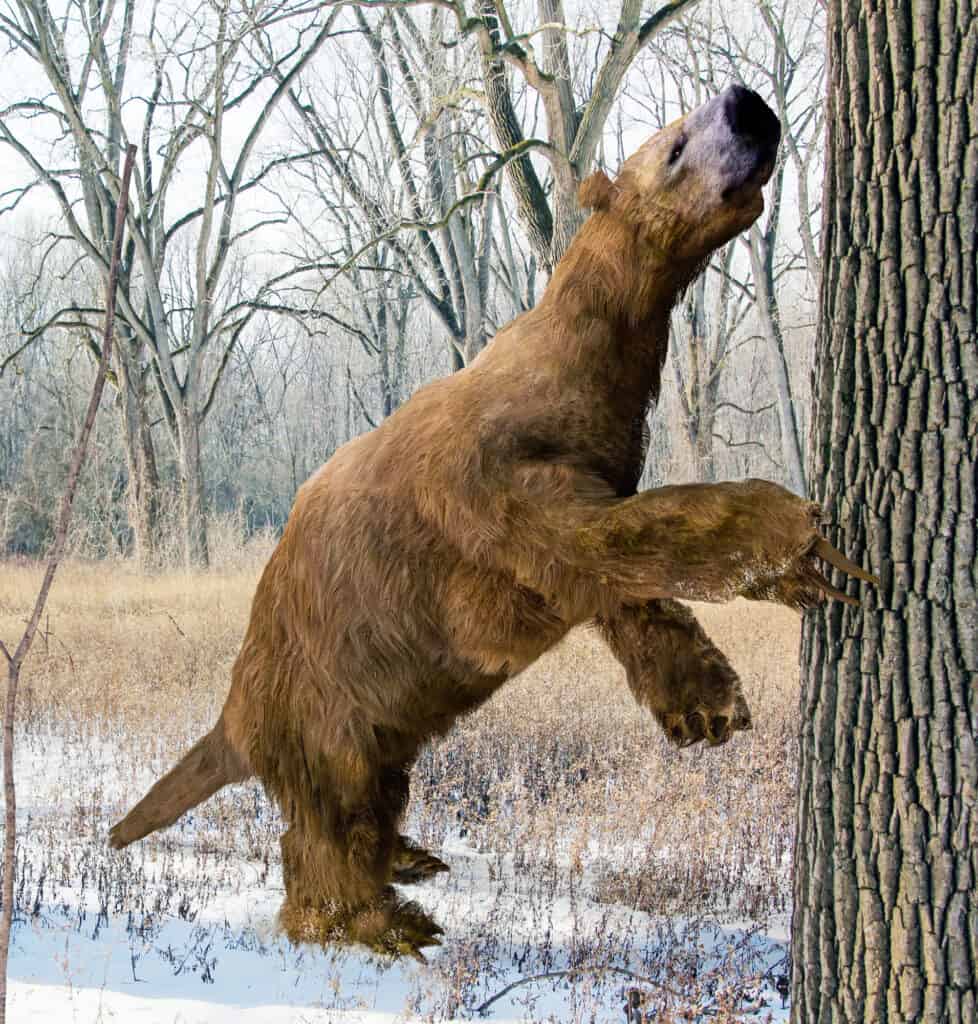
Giant ground sloths walked on two legs, unlike today’s sloths, making them the largest bipedal mammals ever in existence.
©Aunt Spray/Shutterstock.com
When we imagine sloths, we think of the cute furry small tree hangers we know today. Well, that wasn’t always the case. When it comes to the ground sloth, a lot can be said. Fully grown ground sloths were said to reach lengths of up to 10 ft and weigh anywhere from 1,000 to 2,000 pounds. Since they were so large, they couldn’t hang on trees like modern-day sloths and would roam the ground, hence the name ” sloth. Like other sloths, ground sloths were also herbivores and ate a lot of plants, leaves, cacti, etc.
3. Castoroides
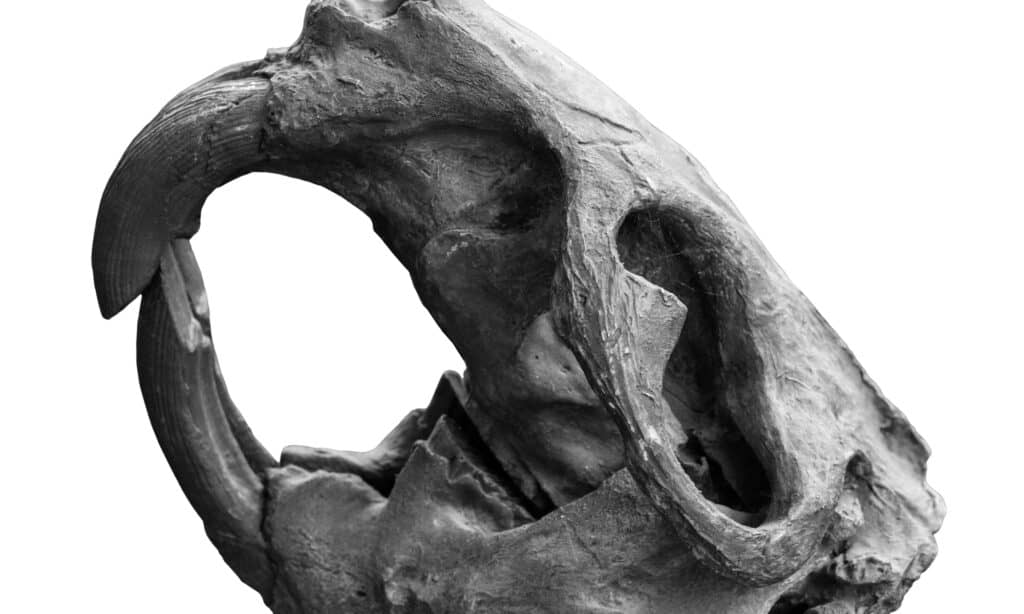
The giant beaver Castoroides ohioensis lived alongside woolly mammoths and another ancient megafauna around 10,000 years ago.
©Art_rich/Shutterstock.com
Castoroides were giant bear-sized beavers that lived throughout North America. These beavers were known for being 7 feet long and weighing more than 200 pounds, and they had incredibly long incisors that could grow to 6 inches. The giant beaver was a herbivore, and studies show that they weren’t eating much woody vegetation but more aquatic plants and leaves. According to some, the extinction of giant beavers may have been caused by their inability to build lodges, climate change, and inadequate housing.
The next extinct megafauna on our list was considered the largest pouched mammal in existence.
4. Diprotodon
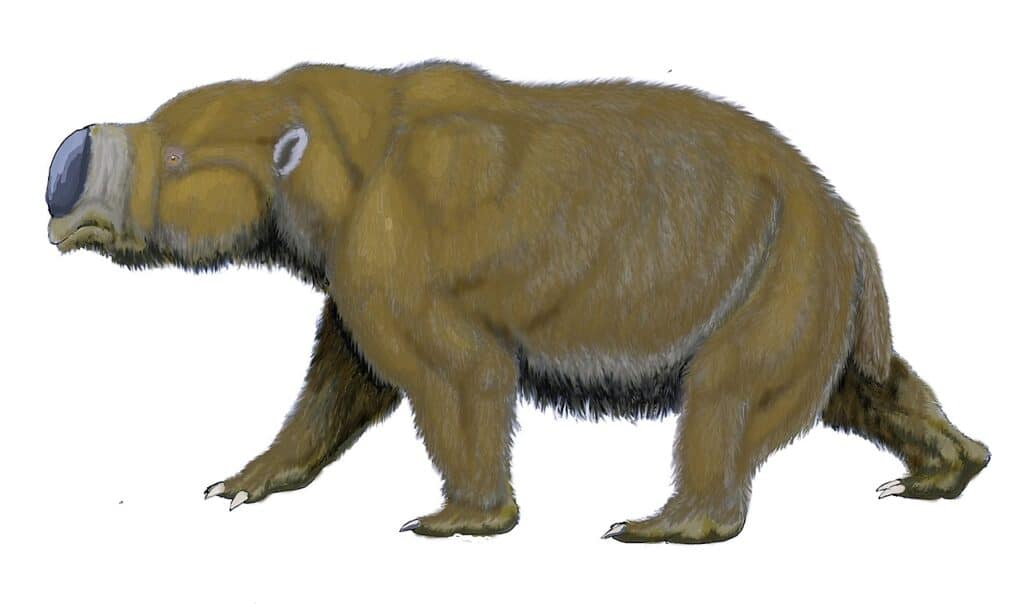
In its heyday, the diprotodon was the largest pouched mammal in existence, measuring 10 feet from snout to tail and weighing up to three tons.
©Dmitry Bogdanov / CC BY 3.0 – License
The diprotodon, also known as the giant wombat, was the largest marsupial mammal ever lived. From nose to tail, this incredible wombat reached an extensive 10 ft long and weighed over 6,000 pounds. They were said to have inhabited Australia over 25,000 years ago. The diprotodon was considered an herbivore and consumed abundant plants, leaves, and shrubs. Several factors are believed to have led to these massive beasts’ extinction, including climate changes and increased hunting from humans.
5. Leedsichthys problematicus

“Leeds fish” (leedsichthys problematicus) is a giant fossil fish that lived during the Jurassic period.
©Dmitry Bogdanov / CC BY 3.0 – License
The Leedsichthys problematicus is said to have been one of the largest fish ever to exist. This massive creature lived over 165 million years ago, and some reached lengths of 100 feet! Although scary in size, this large bony fish was known to be more of a filter feeder than a prolific prey hunter. Ingesting huge gulps of water allowed the Leedsichthys problematicus to consume shrimp and other small marine animals. The extinction of this large fish is uncertain, but it is assumed that the dramatic drop in krill populations played a role.
6. Dire Wolf

Dire wolves are an extinct species of canine that inhabited North and South America and Canada over 10,000 years ago. It is believed that dire wolves are related to gray wolves, the ancestors of all dog species. It is believed that dire wolves were larger than any wolf species today. They could weigh up to 200 pounds and be equipped with incredibly sharp canine teeth used to hunt for prey. Research indicates that they also used these fangs to crush the bones of their victims as well as slice through meat. They could obtain all the nutritional benefits of their meal by consuming bone marrow.
7. Argentavis magnificent
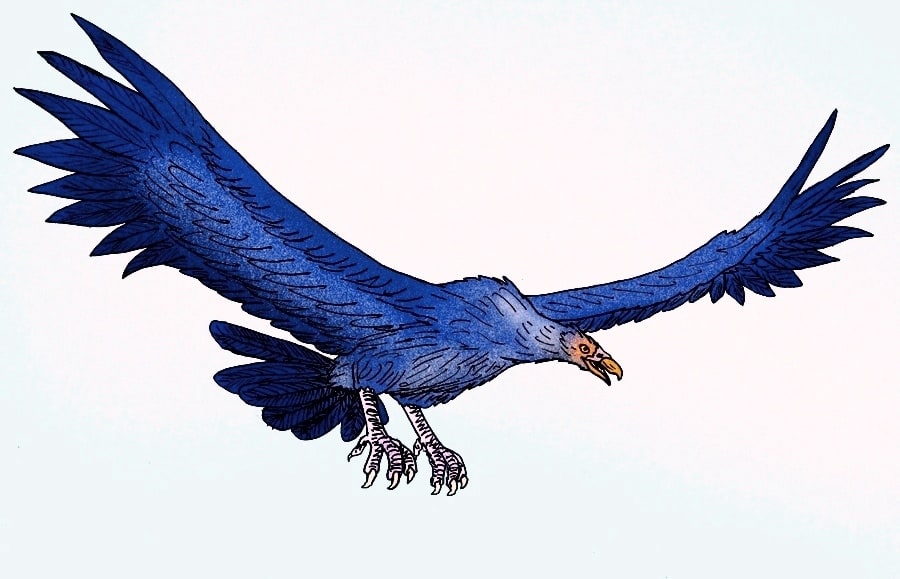
Argentavis was the largest group of flying birds in history.
©Radomil / CC BY-SA 3.0 – License
Until 6 million years ago, the argentavis magnificens was the largest flying bird on our planet. These massive creatures were truly impressive in their sheer size. They stood tall at a height of 4 to 6 feet, but their wings are what scientists are most fascinated by. Their wingspan alone measured 7 meters! They were known for being excellent gliders as their wings allowed for complete control. The argentavis magnificens was a carnivore and consumed a very high intake of meat daily to feed themselves. This usually consisted of prey such as armadillos, small rodents, and even the young of larger creatures such as ground sloths.
Next on our list, we have an extinct megafauna that is considered the largest dinosaur to have ever existed.
8. Argentinosaurus
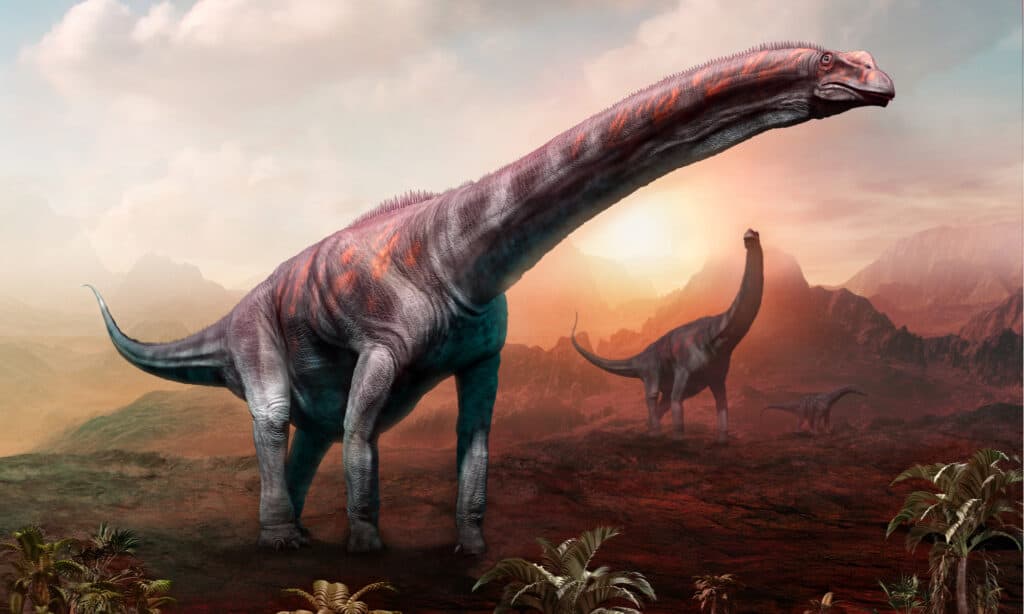
Argentinosauruses were almost as large as American football fields.
©Warpaint/Shutterstock.com
The Argentinosaurus is known as the world’s biggest dinosaur. They were estimated to be over 100 feet in length and possibly weighed 200,000 pounds from head to tail. This dinosaur was an herbivore that consistently fed to maintain its massive size. Since it was so large, the argentinosaurus was also incredibly slow, only going about 5 miles per hour. Argentinosaurus lived over 100 million years ago during the Cretaceous period until it became extinct.
9. Gigantopithecus

Many believe the modern human race originated in the same region where the Gigantopithecus fossils were discovered, in southern China.
©Concavenator / CC BY-SA 4.0, , via Wikimedia Commons – License
Gigantopithecus, the world’s largest primate, lived in what is now China for 9 million years before becoming extinct. With a height of 10 feet and a weight of 1000 pounds, these giant apes were true kings of the jungle. This primate was so large that researchers believe it used its knuckles to move around like modern gorillas. We have urban legends such as bigfoot and sasquatches because some believe that gigantopithecus never went extinct.
10. Daeodon
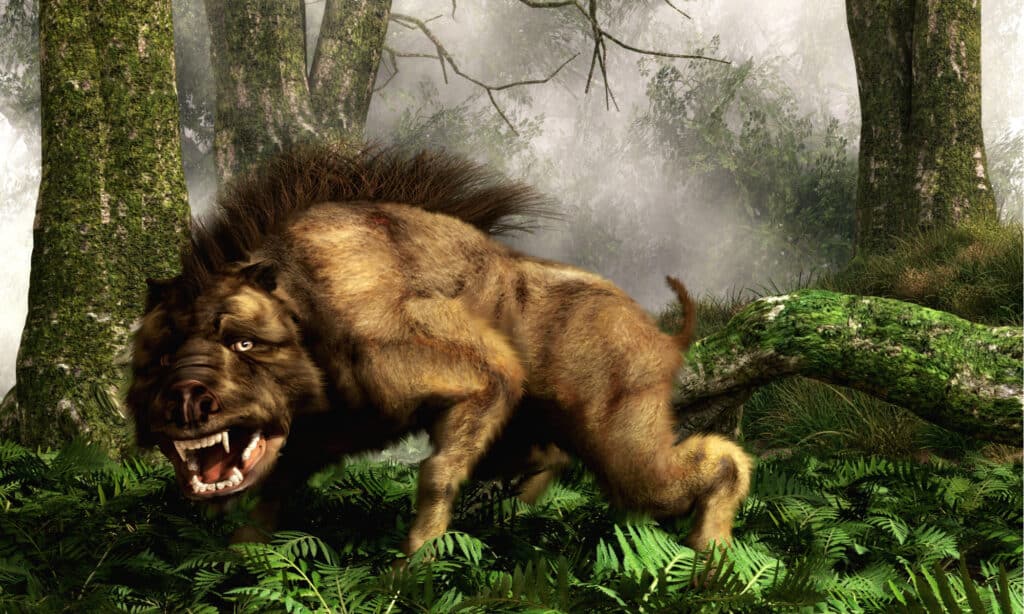
As an amazing extinct megafauna, the Daeodon lived around 20 million years ago during the Oligocene and Miocene epochs.
©Daniel Eskridge/Shutterstock.com
The Daeodon was a large species of pig-like mammal. They appeared similar to warthogs but were as large as rhinoceros and hippos – reaching weights over 2,000 pounds. In contrast to an average pig, this pig’s nostrils were placed on the sides of its head rather than facing forward. Daeodons were mostly scavengers, and the placement of their nostrils allowed them to pick up a wide range of scents to find their food. The Daeodon went extinct over 16 million years ago due to temperature and climate changes.
Summary of 10 Extinct Megafauna
| # | Extinct Megafauna | Modern Relative | Weight |
|---|---|---|---|
| 1 | Glyptodon | Armadillos | 4,000 pounds |
| 2 | Giant Ground Sloth | Sloths | 2,000 pounds |
| 3 | Castoroides | Beavers | 200 pounds |
| 4 | Diprotodon | Wombats | 6,000 pounds |
| 5 | Leedsichthys problematicus | Fish | 99,208 pounds (45 metric tons) |
| 6 | Dire Wolf | Gray wolf, all dogs | 200 pounds |
| 7 | Argentavis magnificent | Birds of prey | 154 – 159 pounds |
| 8 | Argentinosaurus | 200,000 pounds | |
| 9 | Gigantopithecus | Apes | 1,000 pounds |
| 10 | Daeodon | Warthogs | 1,322 – 2,204 pounds (600 – 1000 kg) |
The photo featured at the top of this post is ©
Thank you for reading! Have some feedback for us? Contact the AZ Animals editorial team.






